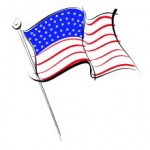Happy July! For those of us living in the U.S.A., we’re gearing up to celebrate Independence Day. As our thoughts turn to fireworks, barbecues, and sharing time with family, I’d like to take a moment to recall the turning point that led us here.
The Declaration of Independence

A quick 1776 timeline:
June 7: Virginia delegate Richard Henry Lee, during the Second Continental Congress in Philadelphia, puts forward a motion for independence from Britain. It’s seconded by John Adams.

Resolved: That these United Colonies are, and of right ought to be, free and independent States, that they are absolved from all allegiance to the British Crown, and that all political connection between them and the State of Great Britain is, and ought to be, totally dissolved.
June 11: Congress appoints a committee to draft a Declaration. On the committee are Thomas Jefferson, John Adams, Benjamin Franklin, Roger Sherman, and Robert R. Livingston. The committee decides to give Jefferson the task of putting together a first draft.
June 12-27: Jefferson works on the Declaration, and the committee reviews and makes revisions before presenting it to Congress.
June 28: The committee’s draft of the Declaration of Independence is read in Congress.
July 1-4: Debates and revisions of the document.
July 4: Congress adopts the Declaration of Independence. July 4-5, broadside copies are printed by Dunlap (a local Philadelphia printer) and sent by horseback to all thirteen colonies, various assemblies and councils.
July 6: The Philadelphia Evening Post is the first newspaper to print the entire text of the Declaration of Independence.
July 8: The first proclamation (reading aloud) of the Declaration of Independence takes place in the State House in Philadelphia, followed by another proclamation later that day to the militia.
July 9: George Washington reads the Declaration aloud to the Continental Army in New York. A rowdy crowd later that day tears down a statue of George III in the square, which is later melted down and made into 42,000 musket balls for the army. Ironic, eh?
During the month of July, as word spread – through newspapers and additional public proclamations throughout the colonies – America celebrates its first “Fourth of July” with bell ringing, musket-firing, and burning of effigies of the King.
Ah, but we’re not “official” yet.
July 19: Congress orders the Declaration of Independence to be officially inscribed by its members.
August 2: Signing begins. Richard Henry Lee, the man who started the motion in Congress but had gone home before the vote, signs the document.
 Some interesting tidbits about the Declaration of Independence:
Some interesting tidbits about the Declaration of Independence:
- The oldest signer was Benjamin Franklin (70); the youngest was Edward Rutledge, from South Carolina (26).
- 8 of the 56 men who signed the document were born in Britain.
- Additional copies have been found in the past 25 years. In 1989, a man in Philadelphia found a Dunlap broadside inside a picture frame he bought at a flea market for $4. It later sold for 8.1 million. Another broadside was found in the British National Archives in 2009. It had been in a box of papers from American revolutionaries captured during the war, and languished in obscurity for centuries.
Want to read more?
History.com: 9 Things You May Not Know About the Declaration of Independence
The Declaration of Independence: the first public readings
National Park Service: the Signers of the Declaration
USHistory.org: The Declaration of Independence
U.S. Department of State (the Office of the Historian): The Declaration of Independence
Just for fun…
One of my favorite scenes from the musical 1776: “Sit down, John!”
How do you celebrate American independence? If it’s not a holiday for you, what’s your opinion of our antics on that day? I’d love to hear from you.
Until next time,
Kathy



Well leave it to Kathy to make a history lesson out of a day off from work.
Oh, I know, I know, I should remember the significance of the day, but this year, it’s just a friggin’ day off of work; a day when I can sit me arse in me chair in me house and write.
Thanks for sharing the fun.
Patricia Rickrode
w/a Jansen Schmidt
Patricia, no matter how you spend your day off, enjoy! And thanks for stopping by. 😉
Love it! Thanks, Kathy. 🙂
Thanks, Kass! Happy Fourth to you and yours. 😀
You left one thing out: when does John Hancock make a fortune in insurance with that over-the-top signature? He must have been marketing himself even then!
Great timeline, thanks Kathy!